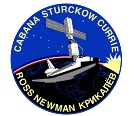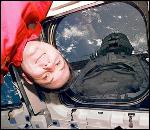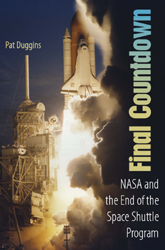|

Pat Duggins
Senior News Analyst
pduggins@wmfe.org
December 1, 2008—Endeavour is back safely, and this week marks ten years since the launch of one of its most famous missions. Five astronauts and a Russian cosmonaut delivered the first U.S. built section of the International Space Station. The mission was marked by a practical joke and, at one point, a surprising lack of kibitzing.
 Kennedy Space Center’s new director, Bob Cabana, was Shuttle Commander of STS-88. Its crew patch is pictured at the left. The flight, in 1998, carried up the barrel shaped U.S. Module called “Unity” to Earth orbit and connected it to the first Russian section called Zarya. The flight plan called for the Shuttle crew to grasp Zarya with Endeavour’s robot arm and snap it onto Unity in the Space Shuttle’s cargo bay. I sat down with Cabana to talk about that mission. The four-time veteran astronaut recalled the most “white knuckle” moment was when Endeavour’s computers switched on the auto-pilot and accidentally pushed the Shuttle on a collision course toward Zarya. Kennedy Space Center’s new director, Bob Cabana, was Shuttle Commander of STS-88. Its crew patch is pictured at the left. The flight, in 1998, carried up the barrel shaped U.S. Module called “Unity” to Earth orbit and connected it to the first Russian section called Zarya. The flight plan called for the Shuttle crew to grasp Zarya with Endeavour’s robot arm and snap it onto Unity in the Space Shuttle’s cargo bay. I sat down with Cabana to talk about that mission. The four-time veteran astronaut recalled the most “white knuckle” moment was when Endeavour’s computers switched on the auto-pilot and accidentally pushed the Shuttle on a collision course toward Zarya.
 Up to that point, whenever Cabana made a maneuver with the Shuttle, fellow astronaut James Newman was full of suggestions on how to proceed. However, when Cabana dove for the controls to prevent Endeavour and Zarya from crashing into each other, Newman was strangely quiet. “Jim, you didn’t jump in and say anything,” Cabana recalled of the incident. “I know enough when to shut the (blank) up,” Newman responded. Cabana is pictured here near he aft windows of Endeavour. The Unity module with the Russian Zarya compartment form a tower rising out of the Shuttle's cargo bay. Up to that point, whenever Cabana made a maneuver with the Shuttle, fellow astronaut James Newman was full of suggestions on how to proceed. However, when Cabana dove for the controls to prevent Endeavour and Zarya from crashing into each other, Newman was strangely quiet. “Jim, you didn’t jump in and say anything,” Cabana recalled of the incident. “I know enough when to shut the (blank) up,” Newman responded. Cabana is pictured here near he aft windows of Endeavour. The Unity module with the Russian Zarya compartment form a tower rising out of the Shuttle's cargo bay.
 Cabana also had anecdote about a practical joke Newman and Cosmonaut Sergei Krikalev played on crewmate Nancy Currie. That story made it into “Final Countdown: NASA and the End of the Space Shuttle Program.” I’d tell you what it was, but that would spoil the punch line. Hardcover copies of the book are available at local bookstores or on amazon.com. An updated paperback version comes out in the Spring of 2009. Cabana also had anecdote about a practical joke Newman and Cosmonaut Sergei Krikalev played on crewmate Nancy Currie. That story made it into “Final Countdown: NASA and the End of the Space Shuttle Program.” I’d tell you what it was, but that would spoil the punch line. Hardcover copies of the book are available at local bookstores or on amazon.com. An updated paperback version comes out in the Spring of 2009.
Photos courtesy of NASA
|
|
|